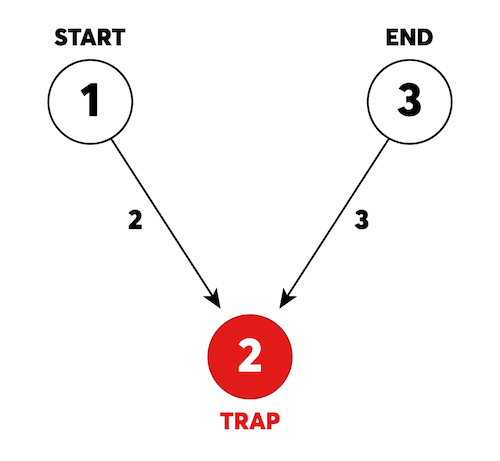🖇️ 문제 링크
코딩테스트 연습 - 미로 탈출
신규 게임 '카카오 미로 탈출'이 출시되어, 라이언 이 베타테스터로 참가했습니다. 위 예시 그림은 카카오 미로 탈출의 초기 상태를 나타냅니다. 1번부터 3번까지 번호가 붙어있는 3개의 방이 있고, 방과 방 사이를 연결하는 길에는 이동하는데 걸리는 시간이 표시되어 있습니다. 길은 화살표가 가리키는 방향으로만 이동할 수 있습니다. 미로에는 함정이 존재하며, 함정으로 이동하면, 이동한 함정과 연결된 모든 화살표의 방향이 바뀝니다.
 https://programmers.co.kr/learn/courses/30/lessons/81304
https://programmers.co.kr/learn/courses/30/lessons/81304
📝 문제 분석

평범한 다익스트라 문제에 트랩이라는 매커니즘을 적용시켜야 하는 문제입니다.
트랩은 최대 10개가 있을 수 있기 때문에 2^10, 총 1024개의 그래프가 나올 수 있습니다.
이를 모두 저장하고 있을 수는 없기 때문에, 트랩들의 인덱스를 비트로 표현하여 저장합니다,
// 다익스트라, 다음 노드를 찾는 과정
for(Edge next : adj[curNode]) {
int nextNode = next.to;
int nextCost = next.cost;
int isReverse = next.state;
if(isReverse != (isConnected(curNode, nextNode, curState, trap) ? 1 : 0))
continue;
int nextState = getNextState(curState, nextNode, trap);
nextCost += curCost;
if(nextCost >= dist[nextNode][nextState])
continue;
dist[nextNode][nextState] = nextCost;
pq.add(new Edge(nextNode, nextCost, nextState));
}현재 노드와 다음 노드의 상태에 따라 그래프의 형태가 달라지게 됩니다.
- 현재 노드, 다음 노드 둘다 트랩이 아닐 때 or 둘 다 트랩이고 활성화 상태일 때 : 원래 그래프 그대로 사용
- 둘 중 하나만 트랩이고 활성화 상태일 때 : 거꾸로 된 그래프 사용
int[][] dist = new int[n + 1][1 << 10];
최단 거리를 찾는 배열도 현재 그래프 상태를 고려해서 계산해야하기 때문에 dist[정점 번호][그래프 상태] 형태로 구현합니다.
⌨️ 코드
import java.util.*;
class Solution {
public int solution(int n, int start, int end, int[][] roads, int[] traps) {
List<Edge>[] adj = new ArrayList[n + 1];
Map<Integer, Integer> trap = new HashMap<>();
int ans = (int)1e9;
for(int i = 1; i <= n; i++)
adj[i] = new ArrayList<>();
for(int[] road : roads) {
adj[road[0]].add(new Edge(road[1], road[2], 0));
adj[road[1]].add(new Edge(road[0], road[2], 1));
}
for(int i = 0; i < traps.length; i++)
trap.put(traps[i], i);
// 다익스트라
int[][] dist = new int[n + 1][1 << 10];
for(int i = 1; i <= n; i++)
Arrays.fill(dist[i], (int)1e9);
PriorityQueue<Edge> pq = new PriorityQueue<>();
pq.add(new Edge(start, 0, 0));
dist[start][0] = 0;
while(!pq.isEmpty()) {
Edge cur = pq.poll();
int curNode = cur.to;
int curCost = cur.cost;
int curState = cur.state;
// end에 도착했을 때
if(curNode == end) {
ans = Math.min(ans, curCost);
continue;
}
if(curCost > dist[curNode][curState])
continue;
for(Edge next : adj[curNode]) {
int nextNode = next.to;
int nextCost = next.cost;
int isReverse = next.state;
if(isReverse != (isConnected(curNode, nextNode, curState, trap) ? 1 : 0))
continue;
int nextState = getNextState(curState, nextNode, trap);
nextCost += curCost;
if(nextCost >= dist[nextNode][nextState])
continue;
dist[nextNode][nextState] = nextCost;
pq.add(new Edge(nextNode, nextCost, nextState));
}
}
return ans;
}
public int getNextState(int curState, int nextNode, Map<Integer, Integer> trap) {
if(trap.containsKey(nextNode))
curState ^= (1 << trap.get(nextNode));
return curState;
}
public boolean isConnected(int curNode, int nextNode, int curState, Map<Integer, Integer> trap) {
boolean currNodeTrapChk = false, nextNodeTrapChk = false;
if(trap.containsKey(curNode))
currNodeTrapChk = ((curState & (1 << trap.get(curNode))) != 0);
if(trap.containsKey(nextNode))
nextNodeTrapChk = ((curState & (1 << trap.get(nextNode))) != 0);
return currNodeTrapChk ^ nextNodeTrapChk;
}
class Edge implements Comparable<Edge> {
int to, cost, state;
Edge(int to, int cost, int state) {
this.to = to;
this.cost = cost;
this.state = state;
}
@Override
public int compareTo(Edge o) {
return this.cost - o.cost;
}
}
}
Uploaded by Notion2Tistory v1.1.0